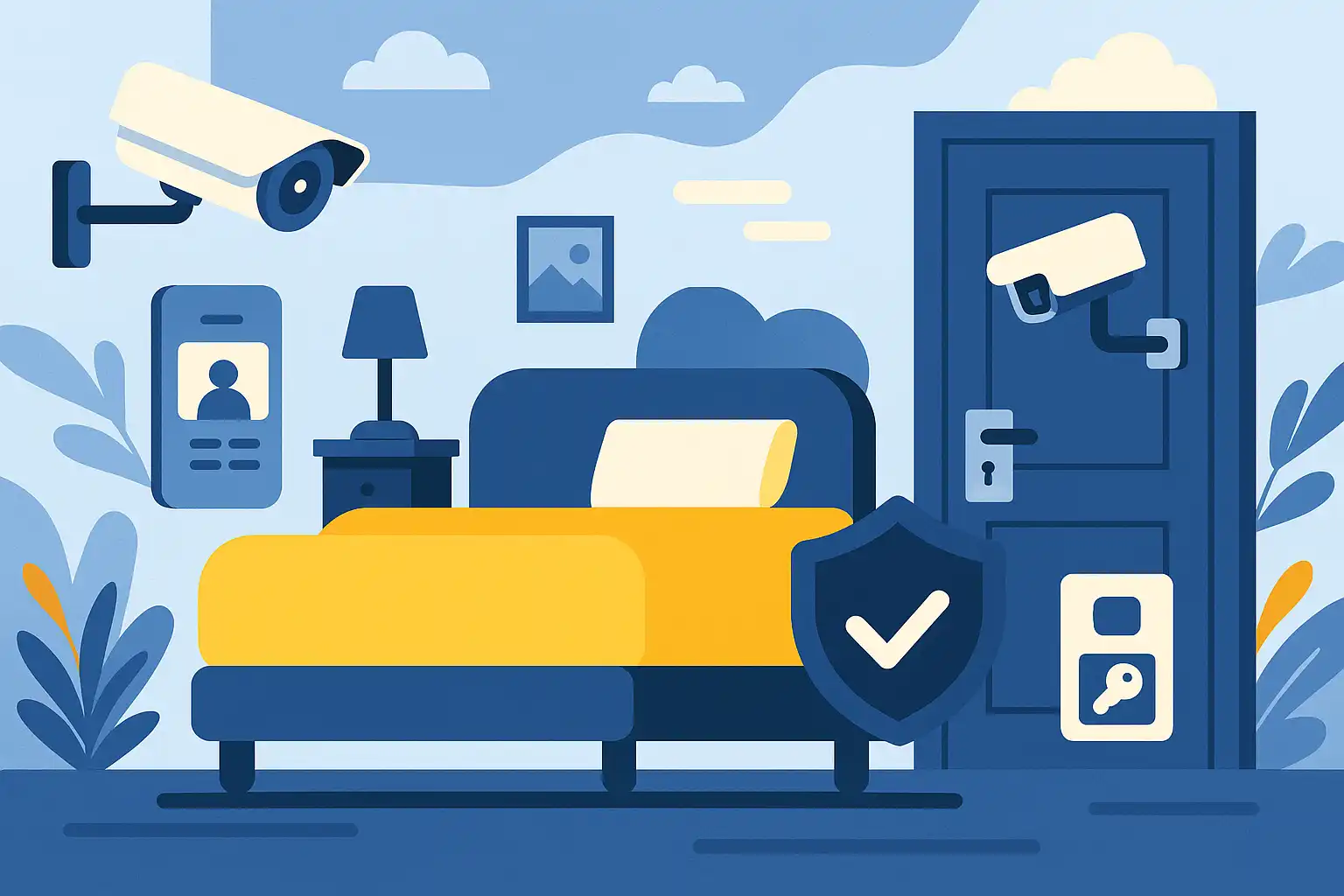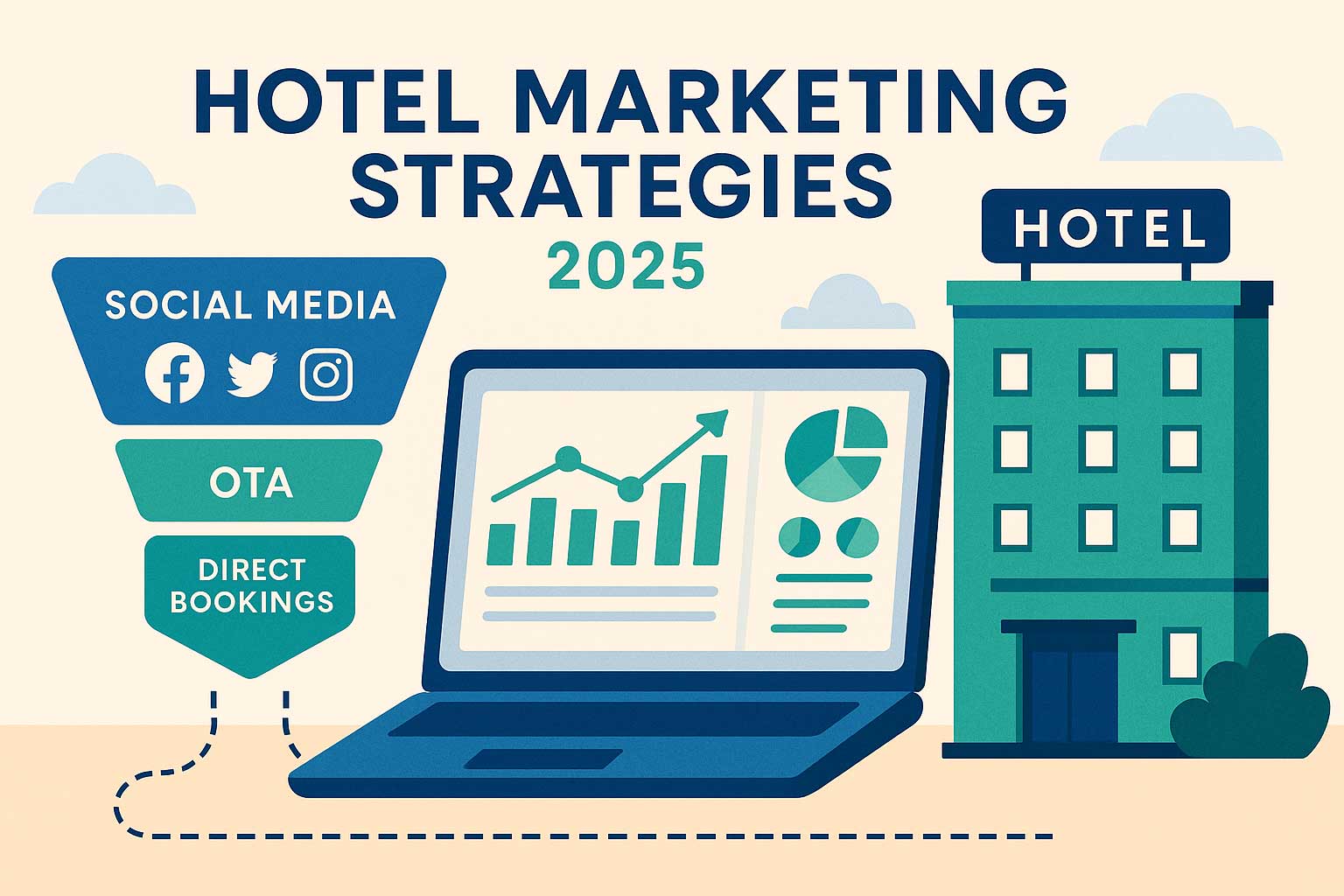Hotel Profit Margin: Guide to Understanding and Improving Your Hotel Profitability
Sep 9, 2025
 Mika Takahashi
Mika TakahashiPopular Categories
Hotel Technology & InnovationHotel Operations OptimizationDigital MarketingIndustry TrendsRevenue ManagementHospitality Industry
Popular Categories
Trending Post

Hotel Walk Letter Template: Professional Guest Communication

Online Travel Agents: What They Are and How They Work

Hotel Security Systems: Modern Protection Solutions

Hotel Advertising: Complete Guide to Boost Bookings and Revenue

25 Hotel Marketing Strategy Ideas for 2025: Complete Guide

AI Reservation Agent: Revolutionizing Hotel Booking and Guest Experience

PMS Communication: Streamlining Property Management Through Effective Guest Messaging
Table of contents
Getting a good handle on your hotel profit margin isn’t just about crunching numbers—it’s about unlocking the true potential of your property. In the hospitality world, how efficiently you run your operations directly affects your bottom line. Mastering profit margin analysis and learning smart optimization strategies can be the difference between thriving and just getting by.
This all-in-one guide will take you through everything you need to know about hotel profit margins—from the basics of how to calculate them to advanced tips for boosting your hotel profitability. Whether you’re a seasoned hotel owner or new to the hospitality scene, you’ll find practical strategies to help you stay competitive in today’s challenging market.

What is Hotel Profit Margin?
Simply put, hotel profit margin shows you what percentage of your revenue remains after covering all operating expenses. It’s calculated as (Net Income / Total Revenue) × 100. This number is a crucial snapshot of your hotel’s financial health and how well your operations are running in the hospitality industry.
To make this clearer, imagine a hotel that pulls in $2.5 million a year but spends $2.1 million on expenses. The profit margin calculation would be: ($2.5 million - $2.1 million) ÷ $2.5 million × 100 = 16%. So, for every dollar earned, the hotel keeps 16 cents as net profit.
It’s important to know the difference between gross profit margin and net profit margin. Gross profit margin looks at revenue minus direct costs, leaving out fixed expenses like loans and depreciation. Net profit margin is more comprehensive, including all expenses, giving you the full picture of your hotel profitability.
Your hotel’s profit margin reflects how well you balance making money and managing costs. A strong margin means you’re running efficient operations, pricing your rooms competitively, and keeping expenses in check—all vital for long-term success in the competitive hotel industry.
Average Hotel Profit Margins by Property Type
Profit margins in hotels usually range from 5% to 35%, depending on the type of property, location, and how well it’s managed. Knowing these benchmarks helps you see how your hotel stacks up and where you can improve.
| Hotel Segment | Profit Margin Range | Average ADR | Key Characteristics |
|---|---|---|---|
| Luxury Hotels | 25-35% | $325+ per night | Premium amenities, high service levels |
| Upscale Hotels | 20-30% | $175-$300 | Full-service offerings, business facilities |
| Midscale Properties | 10-20% | $75-$125 | Limited service, essential amenities |
| Budget/Economy Hotels | 5-15% | Under $90 | Basic accommodations, minimal services |
Luxury hotels tend to lead the pack with the highest profit margins, thanks to premium pricing and guests willing to pay for exceptional experiences. These properties often combine high average daily rates with diverse ancillary revenue streams—think spa services, fine dining, and exclusive amenities—to hit 25-35% margins.
Upscale hotels hold strong margins by running efficient operations and positioning themselves strategically. With 20-30% margins, they balance quality service and cost control, often catering to business travelers and affluent leisure guests.
Midscale hotels face tighter margins as they juggle pricing and service quality. Most in this segment achieve 10-20% margins by focusing on operational efficiency and offering just the right services to keep guests happy without overspending.
Budget and economy hotels work with thinner margins of 5-15%, squeezed by competitive pricing. Success here hinges on excellent cost management and keeping occupancy rates high to meet profitability goals.
How to Calculate Hotel Profit Margin
To figure out your hotel’s profit margin, you need to carefully track all your revenue sources and operating expenses. Here’s a straightforward way to do it:
Step 1: Calculate Total Revenue
Your total revenue comes from multiple places:
- Room revenue (usually 60-70% of total revenue)
- Food and beverage sales
- Spa and wellness services
- Parking and transportation fees
- Resort fees and facility charges
- Event space rentals and catering
Step 2: Identify Operating Expenses
Typical operating expenses include:
- Labor costs (often about 50% of expenses)
- Utilities and energy bills
- Maintenance and repairs
- Marketing and advertising
- Commissions to online travel agencies
- Insurance and compliance costs
- Supplies and guest amenities
Step 3: Apply the Profit Margin Formula
Let’s say a 150-room hotel earns $1.2 million in a quarter, broken down as:
- Room revenue: $840,000
- Food and beverage outlets: $240,000
- Ancillary revenues: $120,000
If total operating expenses add up to $1,020,000, the net profit is $180,000.
Net profit margin = ($180,000 ÷ $1,200,000) × 100 = 15%
A 15% margin is solid, though there’s always room to boost profitability by optimizing revenue and controlling costs.
Tracking monthly margins helps spot seasonal trends and operational hiccups, while annual figures smooth out fluctuations to give a clearer long-term view.

Key Factors Affecting Hotel Profit Margins
Many factors influence your hotel’s profit margin, from where you’re located to how you manage operations and outside economic forces.
Location matters a lot. Urban hotels often enjoy around 18% margins thanks to higher average daily rates and strong business travel demand. Rural hotels might see closer to 12%, limited by seasonal demand and less pricing power.
Seasonality causes big swings. Summer peaks can boost margins by 25% compared to off-season lows. Knowing these patterns helps you plan resources and strategies to maximize profits during busy times.
Labor costs are usually your biggest controllable expense. Rising minimum wages can push costs up 8-12% annually in big markets. Managing labor smartly through cross-training, scheduling, and productivity improvements can make a big difference.
Relying heavily on online travel agencies means paying commissions of 15-25% on room revenue, squeezing margins. Hotels that build strong direct booking channels keep more profit in their pockets.
Energy costs typically eat up 6-10% of operating expenses, and recent price swings add pressure. Investing in energy efficiency can pay off with better margins over time.
Competition and market demand fluctuate, so dynamic pricing and constant market watching are key. Hotels that respond well to competitors while keeping service quality tend to enjoy steadier margins.
Rising Operating Costs in 2025
The hospitality industry is facing some serious cost pressures that impact hotel profit margins across the board.
Labor costs keep climbing, with hourly wages up 11% year-over-year in many places. This reflects ongoing labor shortages and stiff competition for skilled workers.
Energy prices are volatile, with utility bills jumping 15-20% in major markets. Many hotels are speeding up investments in energy-saving tech and smarter management systems.
Supply chain inflation hits daily operations too. Prices for amenities and cleaning supplies have risen about 8%, affecting everything from guest room items to food and beverage.
Insurance premiums for property and liability have gone up 12-18%, driven by higher claims and shifting risk assessments. Hotels must balance coverage needs with cost control to protect their margins.
Essential Metrics for Tracking Hotel Profitability
Keeping an eye on several key performance indicators (KPIs) gives you a clear picture of how your hotel is doing financially.
Revenue Per Available Room (RevPAR) combines occupancy and average daily rate to show how well your rooms are earning. It helps you spot whether pricing or occupancy is the bigger issue.
Total Revenue Per Available Room (TRevPAR) goes beyond rooms to include all revenue streams, providing a fuller view of your hotel’s performance. Hotels with diverse income sources often have higher TRevPAR and steadier margins.
Gross Operating Profit Per Available Room (GOPPAR) looks at profitability per room, making it easier to compare hotels of different sizes. It highlights operational efficiency and helps benchmark against competitors.
Labor Cost Per Available Room (LPAR) tracks how efficiently you’re managing your biggest expense. Keeping labor costs in check boosts profit margins.
Guest Acquisition Cost (GAC) measures how much you spend to bring in each new guest. Lower acquisition costs from direct bookings and repeat visitors usually mean better margins.
| Hotel Segment | RevPAR Target | GOPPAR Target | Labor Cost % |
|---|---|---|---|
| Luxury | $180-250 | $90-125 | 35-40% |
| Upscale | $85-140 | $45-75 | 30-35% |
| Midscale | $50-85 | $25-45 | 25-30% |
| Budget | $35-65 | $15-30 | 20-25% |
These benchmarks give you useful targets to evaluate your performance and spot areas to improve.
7 Proven Strategies to Improve Hotel Profit Margins
Boosting your hotel profit margins means balancing growing revenue with controlling costs. These seven strategies can help you increase margins by 3-8 percentage points when done right.
Successful improvement comes from steady, smart changes—not big, risky moves. Each tactic builds on the others, compounding benefits for stronger financial health.

Optimize Revenue Management and Pricing
Using dynamic pricing can boost your average daily rate by 12-18% during busy times, while keeping you competitive during slower periods. This means adjusting room rates based on demand, competitor prices, and booking trends.
Hotel revenue management systems automate these adjustments using smart forecasting. They analyze booking speed, competitor rates, and market events to help you price rooms perfectly in real time.
Keep an eye on competitor rates so you stay well-positioned and don’t leave money on the table. Regularly reviewing pricing helps you seize extra revenue without hurting occupancy.
Setting minimum stays or length-of-stay rules during peak times prevents less profitable short bookings from taking prime room nights.
Reduce Operational Expenses
Energy-saving programs like LED lighting and smart HVAC can cut costs by 15-25% over time. While they need upfront investment, they typically pay for themselves within 18-24 months.
Cross-train your staff and schedule them based on occupancy to control labor costs, your biggest expense. This can trim labor costs by 8-12% without sacrificing service.
Negotiate better deals with vendors and buy in bulk to save 5-10% on supplies. Reviewing contracts yearly helps spot new savings.
Preventive maintenance cuts emergency repair bills by 30% and extends equipment life, boosting efficiency.
Increase Direct Bookings
Cutting down OTA reliance from 60% to 40% can save you big on commissions and improve guest relationships. Focus on building direct channels where you control pricing and guest data.
Loyalty programs increase repeat bookings by 25% and lower acquisition costs. They create emotional bonds that encourage guests to book direct and spend more.
Make your website and mobile booking easy and friction-free. Even small improvements in booking flow can have a big impact on profitability.
Ensure rate parity and best rate guarantees to build trust and keep your pricing competitive across channels.
Maximize Ancillary Revenue
Upselling spa services, room service, and premium amenities can boost per-guest revenue by 15-20%. Train your staff to spot and act on these opportunities, and reward their success.
Renting event spaces and offering wedding packages taps into high-margin markets, especially during slow periods.
Charging for parking or resort fees adds revenue with minimal extra cost, but be transparent to keep guests happy.
Partner with local attractions and transport for commission-based income and enhanced guest experiences, often adding 3-5% of total revenue.
Implement Cost-Effective Technology
Modern Property Management Systems (PMS) reduce front desk labor by 20% and improve efficiency. Integrated PMS platforms combine reservations, housekeeping, and billing to cut manual work and errors.
Automated check-in and mobile keys reduce staffing needs and appeal to tech-savvy guests, cutting front desk labor by 15-25% during busy times.
Inventory software prevents overbuying and waste, saving 8-12% on supplies.
Guest communication platforms reduce phone calls by 40% and improve satisfaction with faster responses and self-service options.
Focus on Guest Satisfaction and Retention
Happy guests pay more and come back. Improving guest satisfaction can boost your average daily rate by 15%.
Personalized service and tracking guest preferences create memorable stays that drive loyalty and positive reviews.
Managing your online reputation and responding to reviews protects your digital presence and improves bookings.
Reward repeat guests with perks and discounts to reduce acquisition costs and increase lifetime value, often boosting profit margins by 20-30%.
Monitor and Control Food & Beverage Costs
Analyzing menus and food costs can cut expenses by 8-12% without lowering quality.
Track inventory and control portions to reduce waste. Real-time digital systems help spot cost leaks.
Diversify suppliers and adjust menus seasonally to manage price swings while keeping standards high.
Train staff to upsell and minimize waste, increasing sales by 10-15% while cutting costs.
Industry Benchmarks and Performance Standards
Knowing industry benchmarks helps you see how your hotel compares and where to focus improvements.
Margins vary regionally—West Coast hotels often hit 14% net profit margins due to higher costs, while Southeast properties reach 18% thanks to lower labor and energy bills.
Seasonal cycles matter, with summer quarters sometimes showing 40% higher margins than winter. Use this for cash flow and planning.
Chain hotels usually enjoy 2-3% higher margins than independents thanks to scale and brand power, though they face franchise fees and standards.
Recent data shows most segments are bouncing back to or surpassing pre-pandemic profitability, giving a positive outlook.
| Performance Metric | Top Quartile | Median | Bottom Quartile |
|---|---|---|---|
| Net Profit Margin | 22%+ | 14% | 8% |
| Labor Cost % | 28% | 33% | 38% |
| Energy Cost % | 4% | 6% | 8% |
| Guest Satisfaction | 4.5+ | 4.1 | 3.7 |
These numbers help you set realistic goals and track progress.
Common Profit Margin Challenges and Solutions
Hotel owners face many hurdles that can hurt profit margins, but smart strategies can help.
Labor shortages push wages up 15% and increase overtime. Solutions include automation, cross-training, and better employee retention to cut turnover costs.
OTA commissions keep creeping higher. Successful hotels keep commissions below 15% by driving direct bookings and enforcing rate parity.
Insurance and compliance costs rise, adding fixed expenses. Risk management, safety investments, and compliance automation can help control these costs.
Supply chain hiccups and inventory issues affect costs and service quality. Diversifying suppliers and planning inventory carefully keeps things steady.
Energy price swings make budgeting tough. Investing in energy efficiency and renewables brings long-term savings and stability.

Technology Solutions for Profit Margin Optimization
Modern tech tools can seriously boost your hotel profit margins by improving efficiency and revenue management.
AI-powered revenue management systems analyze tons of data to fine-tune pricing, often increasing revenue per available room by 8-15%.
Integrated PMS platforms tie together reservations, housekeeping, and billing to cut manual work and boost guest service. They typically reduce admin labor by 20-25%.
Business intelligence dashboards give you real-time insights into profitability so you can act fast when issues arise.
Guest experience platforms help increase ancillary revenue and direct bookings through personalized offers and upselling, often lifting ancillary revenue by 12-18%.
Expense tracking and budget tools give you detailed spending visibility, helping you keep costs in check while investing smartly.
Cloud-based systems cut IT costs by 15-20% and offer scalable, reliable solutions with advanced features.
Mobile apps let staff access systems anywhere, improving productivity by 10-15% and guest service.
Automated reporting reduces admin burden and speeds up financial insights, enabling quicker, smarter decisions.
Together, these technologies can boost profitability by 5-10 percentage points while enhancing operations and guest satisfaction.
Understanding and improving your hotel profit margin is key to long-term success in this competitive industry. By applying the strategies here—from smart revenue management to cost control—you can strengthen your property’s financial health.
Remember, improving profit margins is a continuous journey. Start with the strategies that fit your property best, then build on your successes as you go.
Combining industry know-how, careful planning, and the right technology sets you up for sustainable profit margin growth. Focus on growing revenue and controlling costs, while delivering the service quality guests expect.
Keep track of key metrics and benchmarks regularly to stay on course and spot new opportunities. With commitment and smart action, you’ll achieve the profit margins you need to thrive in the hotel industry.
